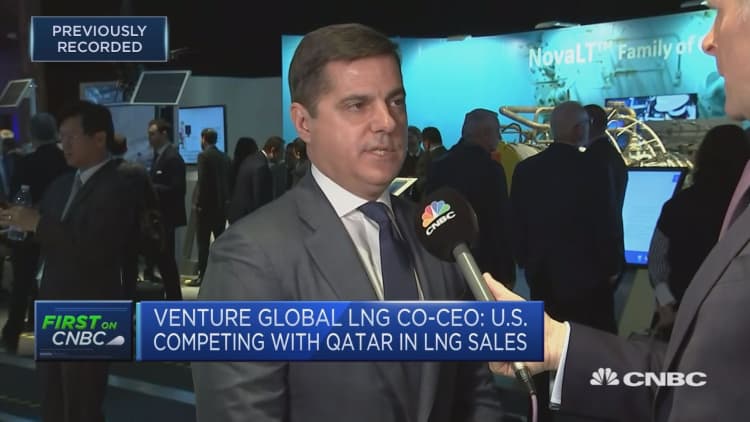The natural gas market is emerging from winter relatively unscathed despite potentially disruptive Chinese tariffs on U.S. gas. But the ongoing trade dispute is still putting a chill on cooperation between the two energy powerhouses and threatens to sideline billions in investment.
Chinese tariffs on U.S. natural gas have halted Beijing's purchases of U.S. LNG, a form of the fuel chilled to liquid form for transport by sea. The trade dispute has also delayed at least one LNG export terminal slated for construction in Louisiana and threatens to push back the start date for other facilities.
In the long-run, analysts say it's inevitable for gas trade to resume between China and the U.S. China is the engine behind growing LNG demand, while the U.S. is the world's top natural gas producer.
They're just the elephant in the room and until there's clarity on where China is going to source their natural gas ... then it's hard for other buyers to make decisions about which projects to attach themselves to.Katie Bayshead of energy and utilities, Height Capital Markets
"They're certainly a very good fit," said Alex Munton, principal analyst for gas and LNG at energy research firm Wood Mackenzie. "On the one hand, China is the fastest growing LNG market and the U.S. is the fastest growing LNG supplier."
But a breakthrough on gas trade depends on reaching a deal on separate issues that are difficult to resolve.
Beijing and Washington are reportedly hammering out a blueprint to address those tough issues, from assuring American companies have access to Chinese markets to protecting U.S. intellectual property. However, it now appears that negotiators will move the goal line back from the original March 1 deadline to strike a deal — forestalling a potential increase in tariffs, but delaying the removal of China's current 10 percent tax on U.S. LNG.
The dispute comes as developers are planning a second wave of U.S. LNG export terminals, mostly along the Gulf Coast. The trade feud is also continuing as the Federal Energy Regulatory Commission on Thursday broke an impasse that held up key approvals for new U.S. LNG export terminals.

Greenlighting those projects usually requires lining up long-term customers who will commit to buying LNG once the terminal is complete.
Despite its appetite for LNG, China has not signed many of those contracts with U.S. companies. Only one American firm, LNG pioneer Cheniere, has signed a long-term contract with a Chinese company since Beijing approved the deals with state-owned enterprises nearly two years ago.
The 'elephant in the room'
Now, the tariffs are creating uncertainty for developers aiming to line up Chinese buyers. Last fall, Australia's LNG Limited said talks with potential Chinese customers stalled because of the tariffs, forcing the company to put off a final decision on financing its planned Magnolia export terminal in Louisiana.
"Clearly there is an issue for some projects if they are targeting the China market," Munton said. "We do think it's going to be difficult in the current context for deals to be signed."
Since Chinese companies are major players in the LNG market — China is now the second largest LNG importer — their reluctance to commit to U.S. projects threatens to keep other buyers on the sidelines, says Katie Bays, head of energy and utilities at Height Capital Markets.
"They're just the elephant in the room and until there's clarity on where China is going to source their natural gas ... then it's hard for other buyers to make decisions about which projects to attach themselves to," she said.
Still, some projects are moving forward. This month, Exxon Mobil and Qatar Petroleum decided to finance their Golden Pass project on the U.S. Gulf Coast.
But analysts say the project is somewhat unique since it's backed by the largest publicly traded oil company and the world's second largest LNG producing nation. Those heavyweights have the financial flexibility to invest through uncertainty, unlike an independent player like LNG Limited, which needs firm commitments from customers to move forward.
But there are signs there's enough demand beyond China to keep some U.S. LNG projects on track for the time being. Last year, developers signed agreements for about 20 million tons in annual sales to support new U.S. capacity, according to Wood Mackenzie.
LNG developers are still getting commitments from energy traders like Trafigura and Vitol, as well as big integrated oil and gas companies that also buy and sell the fuel. State-controlled companies from Poland to Taiwan are also signing agreements.
Proposed North American LNG export terminals, source: FERC
That should allow a few projects to move forward in 2019, including an expansion at Cheniere's Sabine Pass terminal and Venture Global's new Calcasieu Pass facility in Louisiana.
"I think there's enough room with China not embracing U.S. LNG to allow for further gains in LNG exports from the U.S., but it would make things easier if China would take contracts, and they have yet to do it," said Richard Redash, head of research for North American gas and power analytics at S&P Global Platts.
Growing players in LNG spot market
There are obstacles to U.S.-China LNG trade, but the two nations are growing players in the spot market, where LNG is purchased for immediate delivery.
While most LNG is still sold in long-term contracts, China sources about half of its LNG on the spot market, according to Bays. Meanwhile, the U.S. is also unique among suppliers because its relatively young LNG industry is built around selling into the spot market to a greater degree than in other countries.
China's tariff on U.S. LNG introduced inefficiencies into the spot market, threatening to raise prices for all buyers this winter. But warm temperatures in Asia and preemptive stockpiling by China and other regional buyers helped crush LNG prices, swamping any inflationary impact from tariffs.

The benchmark JKM contract for Asian LNG fell from about $12 per million British thermal units when China imposed tariffs on U.S. LNG to just over $6 per mmBtu, according to S&P Global Platts.
Supply has also helped to push down prices. Despite the Chinese tariffs, S&P Global Platts reports the U.S. is still pushing out record amounts of LNG, nearly 5 billion cubic feet a day in February.
"The resource potential in the United States is huge and it can satiate a lot of what China needs," Redash said.
Yet he says the U.S. can't take the Chinese market for granted, even if Washington and Beijing end the trade dispute.
"There will be some competition on the global front on the supply side of the equation, and it's something that we have to watch very carefully, especially over the next year or two."





